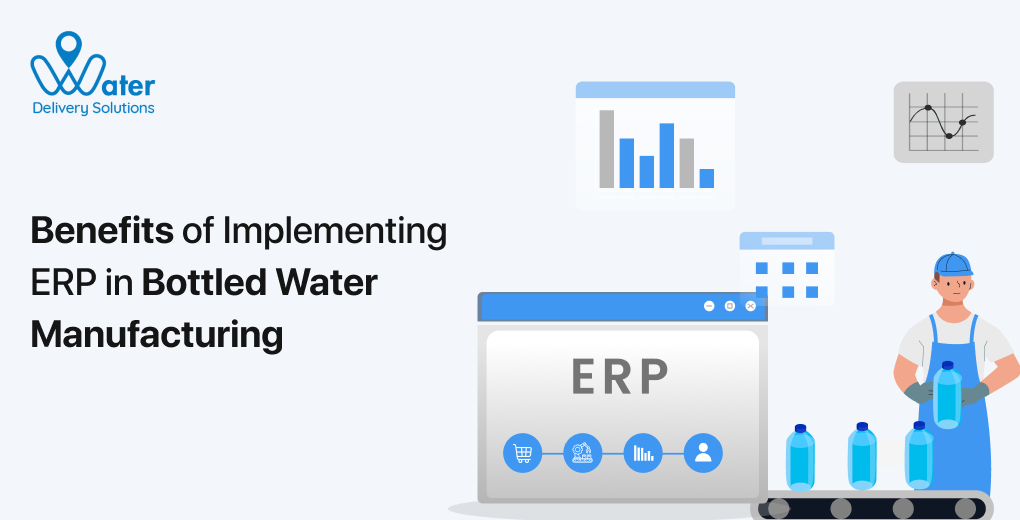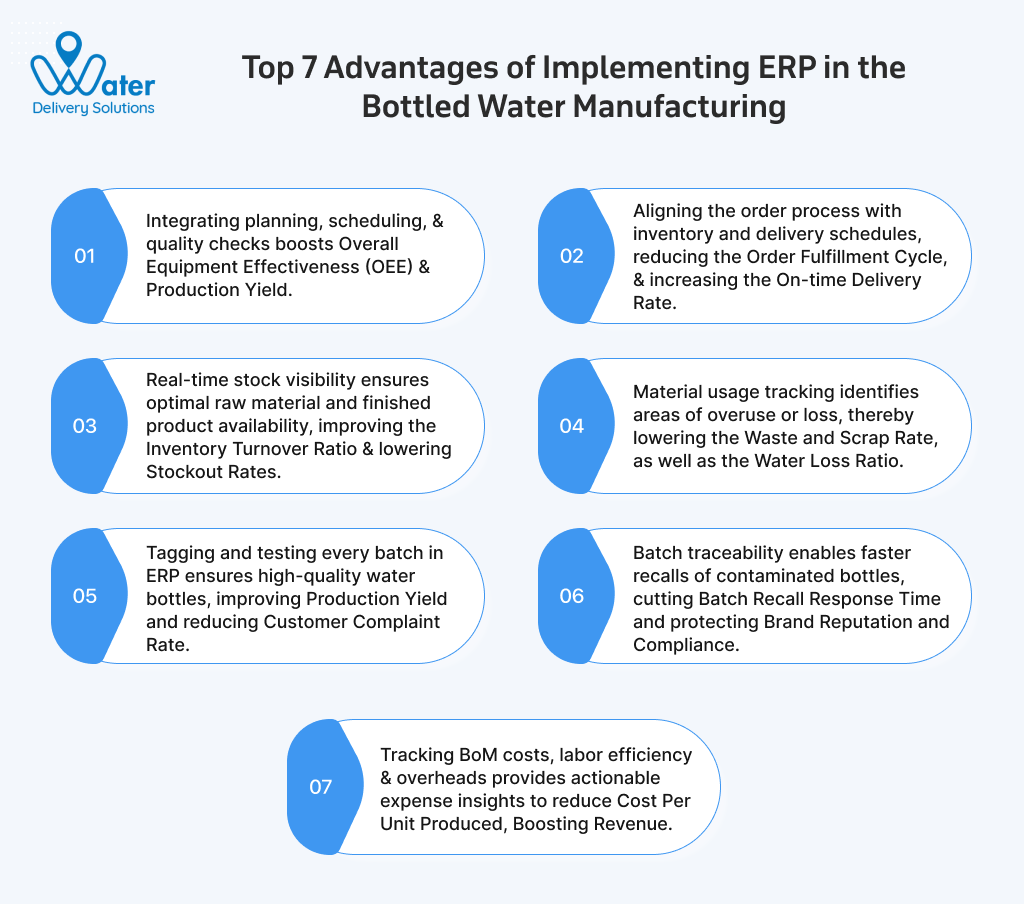The bottled water manufacturing industry is highly dynamic and competitive, making it crucial to implement an integrated solution that ensures accuracy, speed, and consistent quality. If you are a bottled water manufacturing business, you may find the following challenges familiar.
- Low or excessive raw material levels leading to delays in production and deliveries.
- Manual equipment maintenance scheduling might result in sudden breakdowns, delaying production.
- Human-based quality control can be error-prone, resulting in inconsistent quality and frequent product recalls, higher costs, and lower profits.
These are just a few of the many challenges that bottled water companies face. This is where bottled water ERP software comes in. It connects your production, inventory, sales, quality control, and logistics in a single, real-time platform, empowering manufacturers to streamline workflows, optimize resources, and make data-driven decisions. These features and functionalities of ERP offer various benefits that we will discuss in this blog.
Top 7 advantages of implementing ERP in the bottled water manufacturing
The success of a bottled water manufacturing business depends on precision, efficiency, and the ability to maintain consistent quality. Every step in bottled water production affects a business’s profitability and customer satisfaction rates. Advantages of implementing a bottled water ERP system in manufacturing are:
Integrating planning, scheduling, & quality checks boosts overall equipment effectiveness (OEE) and production yield
In bottled water manufacturing, even small inefficiencies such as unplanned downtime, production disruptions, or late detection of quality issues can lead to significant output losses. The bottled water ERP centralizes and synchronizes production planning, equipment scheduling, and quality control in real-time. The features of ERP that help keep them in sync are:
- Production planning – ERP utilizes demand forecasting, current inventory levels, and raw material availability to generate an accurate production plan, ensuring that production aligns with customer orders to avoid overproduction or underproduction.
- Equipment scheduling – The system allocates tasks to the machines in the most efficient sequence. The maintenance schedules are considered to prevent sudden breakdowns, and idle time between production runs is minimized, improving OEE.
- Quality checks – The ERP for bottled water manufacturers integrates quality checks at various stages, including water filtration, filling, capping, and labeling. This ensures that defective units are caught early, reducing rework and waste. Consistent higher product quality reduces batch recalls, driving production yield.
- Real-time monitoring and adjustments – Live performance data enables supervisors to react quickly to machine slowdowns, quality deviations, or supply delays. This agility keeps production on track and prevents efficiency loss.
Key Performance Indicators improvements
- Overall Equipment Effectiveness (OEE) – It is a key performance indicator (KPI) that measures the productivity of a manufacturing process. In bottled water manufacturing, a high OEE indicates that you can produce high-quality bottled water as quickly as possible without stop time. The machines are running more frequently (high availability), manufacturing at their designed speed (performance), and creating fewer defective bottles (quality).
- Production yield – It refers to the percentage of usable product obtained from the total input material or the number of units started in a production process. It is the ratio of raw material converted into finished goods versus lost or wasted. In bottled water manufacturing, a larger number of water bottles pass quality checks the first time, resulting in reduced scrap and rework.
Aligning the order process with inventory and delivery schedules, reducing the order fulfillment cycle, and increasing the on-time delivery rate
In bottled water manufacturing and distribution, customer satisfaction depends on delivering the right quantity of bottles at the right time, especially for customers such as offices, retail outlets, and institutional buyers, who follow strict timelines. Delays can risk losing repeat business and disrupting customers’ operations. The ERP system integrates order processing, inventory management, and delivery scheduling into a consolidated workflow. The features of ERP that align your order processes with inventory and delivery schedules are:
- Order processing – ERP centralizes incoming orders into a single dashboard, eliminating duplicate entries, speeding up processing, and ensuring no orders are missed.
- Inventory alignment with orders – The ERP checks available stock levels for finished bottled water and raw materials (caps, bottles, and labels) when an order is placed. If stock is low, the system triggers replenishment or adjusts production schedules accordingly, preventing last-minute shortages.
- Delivery scheduling – The system integrates logistics and route planning tools to automatically assign orders to delivery trucks based on factors such as location, delivery deadlines, and load capacity. This ensures vehicles are fully utilized and routes are efficient, reducing transit times and fuel costs.
- Automated communication – Customers receive real-time updates on the order status and expected delivery times, reducing the need for follow-up calls and improving trust.
Key Performance Indicators improvements
- Order Fulfillment Cycle Time – It refers to the duration between when a customer places an order and when the product is received. According to Shopify, “lower order fulfillment cycle time leads to greater customer satisfaction and improves retention rates. The bottled water business eliminates manual errors and aligns stock availability with dispatch schedules, helping shorten the time between order receipt and delivery.
- On-time Delivery Rate (OTDR) – It is the percentage of shipments delivered on the promised or expected date. 95% or higher OTDR is considered excellent. OTDR indicates an efficient delivery process and improved customer satisfaction. With better planning and real-time visibility, deliveries arrive as promised, enhancing reliability and satisfaction rates.
Real-time stock visibility ensures optimal raw material and finished product availability, improving the inventory turnover ratio & lowering stockout rates
Inventory management in the bottled water manufacturing business requires a complex balance between raw materials (like caps, bottles, labels, and packaging) and finished goods ready for delivery. Too much inventory can tie up your capital and increase storage costs, while too little inventory can lead to production stoppage or missed deliveries. Features of the bottled water ERP for efficient inventory management are:
- Access to accurate stock levels – The system updates inventory levels as goods are produced, consumed, or dispatched, eliminating discrepancies due to manual data entries and ensuring the numbers on the system match what is physically stored.
- Raw material replenishment – ERP monitors consumption patterns and triggers alerts or automates purchase orders before running out of critical raw materials. This prevents unplanned production stoppages that could lead to delayed shipments.
- Balanced finished goods inventory – The system can align production plans with confirmed orders and forecasted demand to maintain the right stock of bottled water for upcoming deliveries. This avoids overproduction, which increases holding costs and risks production expiration.
- Multi-location stock tracking – For bottled water manufacturers with multiple warehouses or distribution centres, the system consolidates data to provide an overall stock level across all locations. This allows quick stock transfers instead of emergency purchases.
Key Performance Indicators improvement
- Inventory Turnover Ratio – The cost of goods sold divided by total or average inventory indicates how many times inventory is turned or sold in a given period. This ratio determines if there are excessive inventory levels compared to sales. The ERP ensures that you hold only the necessary stock and replenish it on time, enabling the stock to move fast through the supply chain.
- Stockout Rate – This KPI measures the frequency with which a product is out of stock when a customer attempts to purchase it. It determines the ability of your bottled water business to meet customer demand and maintain an optimal inventory level. The ERP software provides real-time alerts and demand-based replenishment, reducing the orders that are not being fulfilled due to a lack of stock.
Material usage tracking identifies areas of overuse or loss, thereby lowering the waste and scrap rate, as well as the water loss ratio
The bottled water manufacturing waste includes overused raw materials, packaging errors, and even water lost during purification, filling, or transfers. These inefficiencies directly impact production costs, sustainability goals, and profitability. The features of ERP for tracking material usage are:
- Raw material monitoring – It includes tracking the consumption of raw materials, such as bottles, caps, and labels, used for each batch. If the usage exceeds the standard bill of materials (BoM), the system flags a discrepancy.
- Packaging waste reduction – The ERP system can monitor packaging line performance to detect high rejection rates from misprints, incorrect labeling, or sealing defects. This allows for quick corrective actions, reducing scrap and saving on packaging material costs.
- Water loss tracking during production – ERP can integrate flow meters and IoT-enabled sensors to track water volumes at various stages, including filtration, bottling, rinsing, and cleaning. If the water loss exceeds the acceptable limit, the system alerts operators to fix the issue.
- Root cause identification for loss – The system consolidates data from production, maintenance, and quality control to help identify whether waste is due to operator errors, faulty machines, or substandard raw materials. This allows targeted corrective measures.
Key Performance Indicators improvement
- Waste and Scrap Rate – It represents the proportion of materials, components, or finished products that are discarded due to any defects, damage, or contamination during manufacturing. Reducing waste and scrap rate minimizes material costs and waste disposal expenses. ERP enables real-time monitoring and corrective action, preventing large quantities from being wasted.
- Water Loss Ratio – It is the proportion of water lost due to any reason during purification and bottling operations. The system detects inefficiencies and leak points, addressing them promptly and reducing the water loss ratio.
Tagging and testing every batch in ERP ensures high-quality water bottles, improving production yield and reducing customer complaint rate
For the beverage industry, especially the bottled water industry, quality is everything. A minor deviation in purity, taste, or packaging can damage brand trust, trigger product recalls, and lead to regulatory penalties. The manufacturers need a reliable way to track and verify quality at every production stage to deliver consistent quality with every delivery. ERP features that ensure that every bottle leaving the plant meets the highest safety and quality standards are:
- Batch tagging – ERP assigns a unique lot or batch number to the raw materials (caps, bottles, and labels). Each batch of bottled water is tagged in the system during production, making it easy to trace every bottle back to its source materials, production date, and machine used.
- Quality checks – The system integrates quality checkpoints into the production workflow, including water purification, bottling, capping, and packaging. The operators must log test results, including pH levels, TDS, microbial counts, and seal integrity, before the batch can proceed to the next stage.
- Automatic hold & quarantine for non-compliant batches – In the case of batch failure, the ERP system automatically flags it for review and can prevent it from being released for delivery. This reduces the risk of defective or unsafe products reaching the market.
- Faster root cause analysis – Every batch is fully traceable, enabling you to identify the exact source of a defect, whether it is contaminated water, faulty caps, or machine malfunctions. This allows you to take corrective actions before the issue spreads.
Key Performance Indicators improvement
- Production Yield – It refers to the amount of usable product obtained compared to the initial amount of raw material or inputs. The production yield determines the efficiency of your bottled water manufacturing process. Early issue detection results in fewer wasted bottles and fewer reworks.
- Customer Complaint Rate – It is a key performance indicator that measures the percentage of customers who have formally complained about your product, service, or overall experience over a period. A lower customer complaint rate determines customer satisfaction and product performance, reflecting how well your bottled water manufacturing is meeting customer expectations. Consistently delivering high-quality bottles to customers reduces returns and refunds and improves brand image.
Batch traceability enables faster recalls of contaminated bottles, cutting batch recall response time and protecting brand reputation and compliance
Even with stricter quality control, there is a possibility of contamination due to raw materials, equipment malfunctions, or packaging defects. When such incidents occur, the speed and accuracy of your recall process determine whether this issue becomes a small, contained issue or a costly public relations crisis. Ways an ERP system allows manufacturers to act quickly and precisely during recalls are:
- End-to-end traceability – ERP assigns and tracks unique batch or lot numbers, from the moment raw water is collected to final delivery of bottled water. This may include sourcing details (supplier or delivery date), production data (machine used and operator involved), and distribution information (warehouse location, delivery routes, & customer lists).
- Pinpointing affected batches – The system allows quality teams to identify the affected batch, its location in the supply chain, and which customers received it. This precision reduces the need for broad, costly recalls and minimizes customer disruption.
- Recall execution – The bottled water ERP software can generate automated notifications to distributors, retailers, and internal teams when an affected batch is identified. The notification instructs them to halt sales or return products. The system also tracks the recall process in real-time.
- Compliance and documentation support – The ERP for bottled water businesses stores complete recall histories, inspection records, and corrective action reports, making it easier to demonstrate compliance with food safety regulations.
Key Performance Indicators improvements
- Batch Recall Response Time – It is the time between identifying a defective batch of a product and initiating the recall process to remove it from the market. It is a critical aspect of product recall management, ensuring timely and effective responses to mitigate potential risks and protect consumers. An ERP system enables your team to easily search production logs or delivery records, reducing batch recall response time.
- Brand reputation – It is the overall perception of a company, product, or service in the minds of the public, customers, stakeholders, and even competitors. Faster recalls reduce negative press, legal risk, and long-term damage to trust.
Tracking BoM costs, labor efficiency & overheads provides actionable expense insights to reduce cost per unit produced, boosting revenue
Profitability in bottled water manufacturing depends on producing high-quality bottles at a lower sustainable cost. However, fluctuating raw material prices, varying labor productivity, and ongoing operational expenses can increase costs unnoticed. The enterprise resource planning system can help bottled water manufacturers gain complete visibility into where every dollar is spent, enabling cost reductions in specific areas without compromising quality. Ways an ERP helps reduce costs and boost revenue are:
- Accurate Bill of Materials (BoM) costing – Every batch production requires a specific set of materials, including plastic bottles, caps, labels, printers, and water. The ERP system records the exact cost of each component in the BoM and updates it dynamically when the supplier price changes. This ensures that production cost calculations are always accurate and reflect real market conditions.
Monitoring labor efficiency – The ERP system tracks labor hours against production output for each batch of water bottles. If the labor time to produce a fixed quantity of bottles increases, the system flags inefficiencies. This enables managers to address training needs, adjust staffing levels, or identify workflow issues. - Overhead expense tracking – The system can also record indirect costs, including electricity for purification and bottling, water treatment chemicals, machine maintenance, and facility rent. Associating these expenses with specific production runs can help managers get “cost per bottle” rather than broad estimates.
- Actionable cost insights – The system centralizes cost data and generates real-time profitability reports for products, batches, or even customers. If a specific bottle size or packaging type is less profitable, production priorities can be adjusted to focus on higher-margin items.
Key Performance Indicators improvements
- Cost Per Unit Produced – Also known as unit cost or cost of goods sold (COGS). It is calculated by dividing the total production cost by the number of units produced. This metric is crucial for bottled water manufacturing to understand its production efficiency and implement appropriate pricing strategies. Identifying and eliminating cost leakages can help you reduce the cost per unit produced, enabling better resource allocation and expense control.
- Revenue Per Unit – It is the amount of money a bottled water business makes from selling one of its products on a unit basis. You can calculate the average revenue per unit by dividing total revenue by the total units sold in a given time. Cost savings boost the margin on each bottle sold, even when the selling prices remain stable.
Conclusion
ERP for bottled water manufacturers can transform operations into data-driven and KPI-focused processes. Implementing the ERP system can help you improve OEE, production yield, order fulfillment speed, inventory turnover rate, waste reduction, and unit cost, impacting operational performance and profitability. This means producing water bottles smartly, fastly, and more profitably, while ensuring consistent quality and meeting customer expectations.
Water Delivery Solutions (WDS) offers an end-to-end ERP system for your bottled water manufacturing & distribution business. It consolidates all your business operations and data into a single platform, providing real-time visibility and traceability of the bottled water supply chain. If you are a bottled water manufacturing and distribution business, book a demo to see how we can help you improve your business efficiency, productivity, and profitability.

He loves to explore. His passion for helping delivery industries in all aspects flows through in the vision he has. In addition to providing smart solution to make delivery process flawless, Ravi also likes to write sometimes to make it easier for people from business industry looking for digital solutions.


